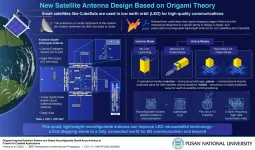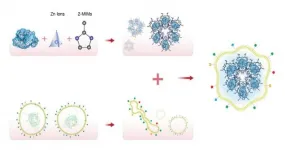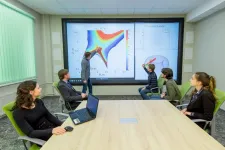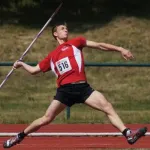Origami-inspired antenna technology for use in small satellites
A multidisciplinary team engineered a small, light, and low-cost deployable antenna for nano- and micro-satellite communications
2021-02-11
(Press-News.org) Modern telecommunication systems rely on satellites to relay signals across the globe quickly and reliably, enabling users to send messages across the world in an instant, watch live television, or - more recently - hold conference calls with global partners right from the kitchen table!
Communications satellites use high-frequency radio waves to transmit data, with antennas acting as a two-way interface, converting electric current provided by the transmitter into radio waves, and vice versa when paired with a receiver. Antennas are therefore vital pieces of equipment, without which satellites and ground receivers would be practically useless. However, despite advances in modern satellite design and performance, antenna technology remains a limiting factor for next-generation telecommunications such as 6G. Engineers struggle to miniaturize antennas for nanosatellites without compromising on their cost or performance. For instance, nanosatellites like CubeSats can be as small as a 10 cm3 cube, but manufacturing a communication antenna small enough to be stored inside it during launch and flight is expensive and technologically challenging. "Many high-performance antennas reported for CubeSat systems are deployable, foldable, or inflatable." explains Dr. Sangkil Kim from Pusan National University in South Korea.
Recently, Dr. Kim and his colleagues at Pusan National University and the University of Alabama, USA, developed a new deployable antenna for CubeSats used in low-earth orbit (LEO). Interestingly, their design was inspired by the mathematics of "origami", the Japanese art of paper folding--specifically a field called spatial mapping--which enabled them to decide on the best geometry for a foldable, deployable antenna. With the design on paper, they set out to manufacture the antenna and test it.
With remarkable dimensions of 32.5 mm3 when folded and weighing merely 5 grams, the prototype antenna fits snugly within a CubeSat. The researchers used an inexpensive material to make the bulk of the antenna, using special joints to fold the square boards into a cube, which can easily be stored during launch and flight. Once in orbit, the antenna can be deployed outside of the CubeSat, ready to receive and transmit data.
Prof. Kim and his team went one step further and set up different deployment modes, depending on whether satellites needed to communicate with each other or with Earth. "The volume, radiation patterns, and polarizations of the antenna are reconfigurable according to the required operation mode," Dr. Kim explains. This configuration enabled the researchers to optimize the antenna's performance for each type of communication.
With such promising results, the scientists hope their design will inspire future deployable designs for nanosatellite antenna technology and pave the way for next-generation communication systems, such as 6G. Not only will their prototype reduce the cost of future nanosatellites and improve their overall performance, but it can also be scaled up to larger satellites in geostationary orbit and other communication platforms on Earth.
INFORMATION:
Reference
Authors: Myeongha Hwang (1), Gyoungdeuk Kim (1), Sangkil Kim (1), Nathan Seongheon Jeong (2)
Title of original paper: Origami-Inspired Radiation Pattern and Shape Reconfigurable Dipole Array Antenna at C-band for CubeSat Applications
Journal: IEEE Transactions on Antennas and Propagation
DOI: 10.1109/TAP.2020.3030908
Affiliations:
(1) Pusan National University, South Korea
(2) University of Alabama, USA
About Pusan National University
Pusan National University, located in Busan, South Korea, was founded in 1946, and is now the no. 1 national university of South Korea in research and educational competency. The multi-campus university also has other smaller campuses in Yangsan, Miryang, and Ami. The university prides itself on the principles of truth, freedom, and service, and has approximately 30,000 students, 1200 professors, and 750 faculty members. The university is composed of 14 colleges (schools) and one independent division, with 103 departments in all.
Website: https://www.pusan.ac.kr/eng/Main.do
About the author
Dr Sangkil Kim is an Assistant Professor at the Department of Electronic Engineering at Pusan National University (South Korea). After receiving a BS from Yonsei University in 2010, he graduated with an MS and a PhD from the School of Electrical and Computer Engineering at the Georgia Institute of Technology. He then worked at Qualcomm Inc. as a senior engineer, where he worked on the world's first commercialized 5G mmWave antenna module for mobile devices. He received several awards, such as the IET Premium Award Microwave, Antennas & Propagation and the KIEES Young Researcher Award. He is a member of the IEEE MTT-26 RFID, Wireless Sensors, and IoT Committees.
[Attachments] See images for this press release:

ELSE PRESS RELEASES FROM THIS DATE:
2021-02-11
With the advent of 5G communication technology and its integration with AI, we are looking at the dawn of a new era in which people, machines, objects, and devices are connected like never before. This smart era will be characterized by smart facilities and services such as self-driving cars, smart UAVs, and intelligent healthcare. This will be the aftermath of a technological revolution.
But the flip side of such technological revolution is that AI itself can be used to attack or threaten the security of 5G-enabled systems which, in turn, can greatly compromise their reliability. It is, therefore, imperative to investigate such potential security threats and explore countermeasures before a smart world is realized.
In a recent study published ...
2021-02-11
Researchers at the University of Virginia School of Medicine have shed light on what causes herpes simplex virus to flare up, explaining how stress, illness and even sunburn can trigger unwanted outbreaks.
The discovery could lead to new ways to prevent cold sores and herpes-related eye disease from reoccurring, the researchers report.
"Herpes simplex recurrence has long been associated with stress, fever and sunburn," said researcher Anna R. Cliffe, PhD, of UVA's Department of Microbiology, Immunology and Cancer Biology. "This study sheds light on how all these triggers can lead to herpes simplex-associated disease."
About Herpes Simplex ...
2021-02-11
Joe Biden is the new president of the United States, although half of the country's Republicans believe he stole the election. A lot of people believe conspiracy theories on the other side of the Atlantic. But they aren't only found there.
Conspiracy theories are not exclusive to people who storm the U.S. Capitol.
"Everyone believes at least one conspiracy theory," says Asbjørn Dyrendal, a professor in NTNU's Department of Philosophy and Religious Studies who specializes in conspiracy theories.
The more conspiracy theories you bring up, the more people answer yes to one of them.
That fact leads ...
2021-02-11
Loading a cancer immunotherapy drug onto a metal organic framework improves both its delivery and its sustained release for treating leukemia. Furthermore, coating the drug-loaded framework with a cancer cell membrane improves targeted delivery to solid tumors. These findings could lead to safer and more reliable cancer immunotherapies.
"We believe our findings are quite significant because they show that the undesirable side effects of immunotherapy can be modulated by choosing the right delivery vehicle," says KAUST chemist Niveen Khashab. "They also show that targeted delivery can be realistically established through proper surface functionalization." ...
2021-02-11
The energy of the future lies in the area of the controlled thermonuclear fusion. The scientific group from Peter the Great St.Petersburg Polytechnic University (SPbPU), headed by Professor Vladimir Rozhansky, is directly involved in the establishment of the world's largest experimental thermonuclear reactor ITER. Researchers discovered new effects, which affect the energy flow in the reactor. The theoretical predictions were confirmed by the experiments on two tokamaks. The research results were published in the scientific journal "Plasma Physics and Controlled Fusion".
The scientific group of Polytechnic University is engaged in modeling of the edge plasma. The researchers aim to identify how and ...
2021-02-11
In the early days of the COVID-19 pandemic, it was established that SARS-CoV-2 infects cells by binding to the human protein ACE2, which plays a role in regulating blood pressure. But ACE2 is almost absent in human lung cells, so how can the lungs be one of the most affected organs in COVID-19? This gave researchers a hint that ACE2 might be more than just a blood pressure regulator, and might not be the only player in the SARS-CoV-2 infection mechanism.
EMBL's Gibson team, in collaboration with Lucía Chemes at Universidad Nacional de San Martín in Buenos Aires and ...
2021-02-11
Research from the Business School (formerly Cass) suggests that observing others' decision-making can teach people to make better decisions themselves.
The research, co-authored by Professor Irene Scopelliti, Professor of Marketing and Behavioural Science, tested the effectiveness of a new debiasing training strategy and reports first evidence that watching others make decisions can improve our own decision making.
The authors carried out three experiments, which involved participants making a set of judgements before and after a training intervention designed to improve their decision-making.
Experiment ...
2021-02-11
A study led by researchers at Lund University in Sweden showed a connection between lifestyle intervention in pregnant women with obesity and epigenetic alterations in the baby. The study is published in the journal Diabetes.
An international collaboration between researchers in Sweden, Denmark and Spain investigated whether children's genes were programmed differently if a pregnant woman with a BMI over 30 underwent lifestyle interventions.
The study involved 425 pregnant women, all of whom have a BMI over 30, which is defined as obesity. They were divided at random into three different groups:
Group 1 had a lifestyle intervention that included both physical activity (they were urged to walk 11 000 steps per day and use a step counter) and a ...
2021-02-11
Those with asthma are experiencing less asthma control related to an increase in using household disinfectants -- known asthma triggers -- because of COVID-19, according to a survey co-conducted by University of Illinois Chicago researchers.
"We became concerned with increased cleaning and disinfecting related to the COVID-19 pandemic, combined with people spending more time indoors may expose people with asthma to more environmental triggers for asthma symptoms," Eldeirawi said. "This prompted our interest in studying the impact of disinfectants and asthma control among those living with asthma."
Cleaning products are considered respiratory irritants that cause inflammation and bronchial hyperresponsiveness, Eldeirawi explained. ...
2021-02-11
American athlete Tom Brady has done the seemingly impossible, winning his seventh Super Bowl at the age of 43 in spectacular fashion. He's joined by stellar company: At 39, Serena Williams has won 23 grand slams, one of them while pregnant.
The reasons for age-defying athletic performances are dependent on numerous factors, including diet, but a new study by Iranian and University of South Australia researchers shows that when it comes to track and field events, the age when athletes peak often depends on the sport.
Discus and javelin throwers as well as marathon runners and race walkers are likely to achieve their best performances at a later age than sprinters, hurdlers and ...
LAST 30 PRESS RELEASES:
[Press-News.org] Origami-inspired antenna technology for use in small satellites
A multidisciplinary team engineered a small, light, and low-cost deployable antenna for nano- and micro-satellite communications






